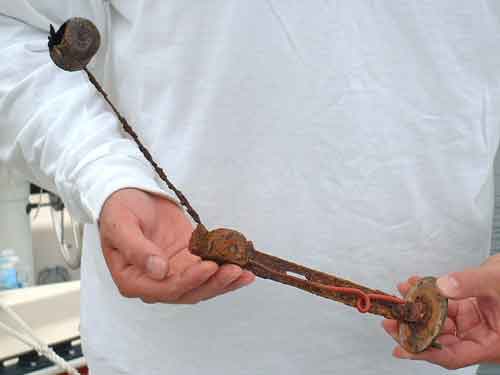Gas Tank & Fuel Sender Corrosion
Previously we published a
warning from Ralph Ainsley of Hyperion, out of Halifax,
about rusty gas tanks. Hyperion's original steel
tank was so rusty, Ralph could poke his finger through the
bottom. The thought of a tankful of gas sloshing around the
bilge "scared
the daylights out of me," he said.
Subsequently, we learned that a Toronto boat, a Mark I, voided
its tank into the bilge while the owner was out enjoying a nice afternoon
sail. With 15 gallons of gas sloshing around the bilge, said
our informant, "it's a good thing [the owner] doesn't smoke."
So... if you've got a steel tank, it's probably seriously
past its replace-by day, whether you sail in salt water or
fresh. Don't delay – check it, or
better, just replace it with a tank approved for permanent under-deck
installation (or you'll void your insurance) in aluminum or polyethylene (
manufacturer 1 and manufacturer 2).
Now Dean M Baldwin of Morgan D, also of Halifax, warns of similar corrosion
in the fuel sender.
"A lot of rust and [bits of the] cardboard gasket fell into and remains in the
¾ full tank. For C$45.00, get rid of the steel and replace. I have replaced
with aluminum and rubber."
"After I proved the gas gauge on
the instrument panel was still functional, I purchased the sender. I chose the
Faria 6" to 16" sender
depth as my tank is 14" deep,
but I had an
option of three different types from the stores in this area. All had the
standard five holes for the bolts."
It takes only a moment to pull the five bolts and check your sender. There is
no certain way to tell the difference from the outside.
Fuel senders have a slightly irregular bolt spacing that ensures correct orientation
of the float arm. Dry-fit the sender and gasket to ensure you have
them positioned the right way before you start running up the screws.
Your fuel pickup should have a small screen on the end to prevent rust particles
from entering the fuel line, plus a filter on the line and one on the engine
itself, but such small screens are prone to blockage, and as we all know from Murphy's
Law and personal experience, engines only quit when you really need them. If you have
a sender like the one above, you should probably clean the tank.
Amusing historical sidelight: One early corollary of the original Murphy's Law
apparently stated that, "When things go wrong, they do so in the direction of maximum destructiveness."
Murphy (there
really was a Murphy behind the Law,
which is now the foundation of "defensive design", aka "idiot-proofing")
was part of a USAF team working on the rocket-powered sleds used
to test variables in pilot safety (early ejection seats, seat belts, etc.), so
we can assume that this group's knowledge of destructiveness was authoritative.

